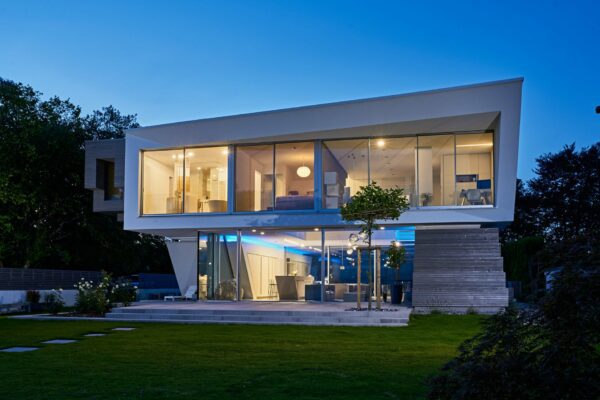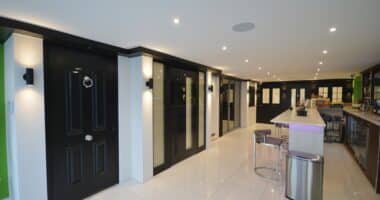Frameless windows are aluminium and glass products designed to provide a contemporary modern aesthetic with maximum visible glass and minimum visible window frame.
So called ‘frameless windows’ are generally fixed windows or floor-to-ceiling glazing with hidden frames, giving an all-glass appearance to provide architectural glazing features; they can also be made primarily of structural glass with a bonded construction. Frameless windows that open will always need a frame and are, therefore, never genuinely frameless but slim-framed.
What are frameless windows?
Some frameless windows are entirely frameless, using structural glazing engineering and technology. Other have a minimal amount of framing. Some are entirely framed, available as double or triple-glazed, however, the frame is hidden in the building structure to create a frameless appearance.
The aesthetic appeal of frameless windows is undeniable. Their sleek, modern look is perfect for creating bespoke architectural glazing, whether for lean-to’s, new extensions, or stand-alone windows in new or existing structural openings. The visual impact can be stunning.
Floor-to-ceiling windows, glass facades, lantern roofs, and other specialist glass products can all incorporate frameless windows, depending on the specific system and how you design it. Bay windows, corner windows, and complex angles and shapes are also possible.
Frameless windows features
Like other modern replacement windows and doors, frameless windows provide homeowners and commercial clients with all the advantages that modern double glazing can bring. You can expect to find the following minimum features and standards in a well-designed frameless window system:
- Excellent thermal performance and low U-Values
- Typically fixed windows, double or triple-glazing
- Extensive glass choices include coloured, acoustic, solar control, and security glass.
- A choice of colour for the aluminium frame
- Aesthetic integration with doors, other windows, glazed extensions and screens
- Great design flexibility with large glass panels
- Create a seamless transition to the outside when used with bifolding or sliding doors.
- The large glass area lets natural light flood in and make the most of views.

What to know and advice when buying frameless windows
Frameless windows are unlike conventional PVCu, aluminium or timber windows; next, we offer some advice on what you need to know about frameless windows in order to make an informed choice
What type of glass is used in frameless windows?
Due to less frame, glass is an even more critical component of the windows. The glass units’ construction and quality help ensure the windows’ longevity and performance. There are many glass options on offer to provide both comfort and security. Typical features of glass found in frameless windows include:
- Quality laminated, float or toughened safety glass from the leading glass processors such as Pilkington Glass or Saint Gobain
- Sophisticated spacer bar construction helps achieve excellent thermal performance
- Quality glass coatings for solar control as well as energy efficiency
- Colouring, polishing and other treatments on exposed glass edges
- A guarantee on the glass unit
Frameless windows guarantee
Be sure to check and compare the guarantees that come with the frameless windows from the various providers and what they cover.
Most manufacturers do not make the glass and will pass on the guarantee their sealed glass unit glass supplier gives. The same may apply to windows with integral blinds, glass coatings and switchable glass. So while they may market the product, for example, with a 10-year warranty, you may find the glass only has five years.
Frameless windows offer fewer personalisation options
The reduced or lack of aluminium framing may limit the colour, handle and other personalisation options commonly available with PVCu, aluminium or timber windows.
Frameless windows and building regulations
While frameless windows can be suitable for new or existing openings, ensure they are building regulations compliant.
One example where you may need to make alternative arrangements is trickle ventilators. Trickle ventilators (or other suitable ventilation) are part of the current building regulations. Some frameless systems will not accept a trickle vent, meaning you must make alternative arrangements to comply with Building Regulations.
Installation can be complicated and expensive
Some systems have hidden structural supports allowing for the creation of expansive windows, some more than 10m2. Due to the large panel sizes, be aware that there may be significant additional costs, such as large vehicles, specialist glass handling equipment, additional labour on site and increased site safety considerations. Also, adequate site access should be ensured for oversized transportation and lift equipment.

Where to buy frameless windows
There are now many specialist installers of architectural glazing who include frameless windows. Our advice is to research the company carefully and ensure they have the expertise and installation track record and that the product has the appropriate certification and meets building regulations.
Frameless windows can be purchased with other frameless products or you can mix or match, there are no hard and fast design rules. One of the main benefits of aluminium products in particular is the ability to mix and match due to the ability to RAL colour match.
If you would like some guidance on who to approach in your area, please get in touch with us, and we will help you.
Latest articles
- Residence 9 vs Evolution Windows: Which Is better? December 9, 2024
- choosing the best Residence collection. R9 vs r7 vs r2. December 6, 2024
- UPVC Flush windows compared November 30, 2024
- Black Friday for windows and doors. Are the offers genuine? November 22, 2024
- Oriel windows and frameless box windows November 17, 2024















